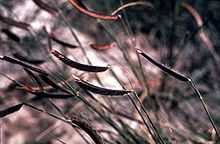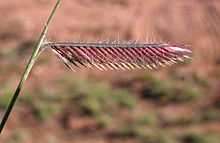Bouteloua gracilis
| Blue grama Bouteloua gracilis | |
|---|---|
 | |
| Scientific classification | |
| Kingdom: | Plantae |
| (unranked): | Angiosperms |
| (unranked): | Monocots |
| (unranked): | Commelinids |
| Order: | Poales |
| Family: | Poaceae |
| Genus: | Bouteloua |
| Species: | B. gracilis |
| Binomial name | |
| Bouteloua gracilis (Willd. ex Kunth) Lag. ex Griffiths[1] | |
Blue grama grass, Bouteloua gracilis, is a long-lived, warm-season, C4 perennial grass, native to North America.[1] It is most commonly found from Alberta, Canada, east to Manitoba and south across the Rocky Mountains, Great Plains, and U.S. Midwest states to Mexico. Blue grama accounts for most of the net primary productivity in the shortgrass prairie of the central and southern Great Plains. It is a green or greyish, low-growing, drought-tolerant grass with limited maintenance.[2]
Description
Blue grama grows on a wide array of topographic positions, and in a range of well-drained soil types, from fine to coarse textured.

The Bouteloua gracilis plant height at maturity ranges from 15–30 centimetres (6–12 in). The roots generally extend 30–46 centimetres (12–18 in) from the edge of the plant, and 0.9–1.8 metres (3–6 ft) deep. Maximum rooting depth is approximately 2 metres (7 ft). Blue grama is green to greyish in appearance.
Blue grama is readily established from seed, but depends more on vegetative reproduction via tillers. Seed production is slow, and depends on soil moisture and temperature. Seeds dispersed by wind only reach a few meters (~6 ft); farther distances are reached with insects, birds, and mammals as dispersal agents. Seedling establishment, survival, and growth are greatest when isolated from neighboring adult plants, which effectively exploit water in the seedling's root zone. Successful establishment requires a modest amount of soil moisture during the extension and development of adventitious roots.
Established plants are grazing-, cold-, and drought-tolerant, though prolonged drought leads to a reduction in root number and extent. They employ an opportunistic water-use strategy, rapidly using water when available, and becoming dormant during less-favorable conditions. In terms of successional status, blue grama is a late seral to climax species. Recovery following disturbance is slow and depends on the type and extent of the disturbance.
Horticulture and agriculture
Blue grama is valued as forage.
Bouteloua gracilis is grown by the horticulture industry, and used in perennial gardens; naturalistic and native plant landscaping; habitat restoration projects; and in residential, civic, and highway erosion control. Blue Grama flowers are also used in dried flower arrangements.
Blue grama is the state grass of Colorado and New Mexico. It is listed as an endangered species in Illinois.[1]

Among the Zuni people, the grass bunches are tied together and the severed end used as a hairbrush, the other as a broom. Bunches are also used to strain goat's milk.[3]
References
| Wikimedia Commons has media related to Bouteloua gracilis. |
- ↑ 1.0 1.1 1.2 "PLANTS Profile for Bouteloua gracilis (blue grama)", Plants.USDA.gov, June 2012, webpage: Bogr2: has classification; map of North America in 30 U.S. states.
- ↑ "Blue Grama - Animal & Range Sciences", Montana Univ., AnimalRangeExtension.Montana.edu, 2011, webpage: MBlue.
- ↑ Stevenson, Matilda Coxe 1915 Ethnobotany of the Zuni Indians. SI-BAE Annual Report #30 (p. 83)
- Sources
- USDA NRCS plant profile: Bouteloua gracilis
- Anderson, M.D. 2003. U.S.D.A. Fire Effects Information System: Bouteloua gracilis - Department of Agriculture, Forest Service, Rocky Mountain Research Station, Fire Sciences Laboratory (Producer).
| Wikispecies has information related to: Bouteloua gracilis |